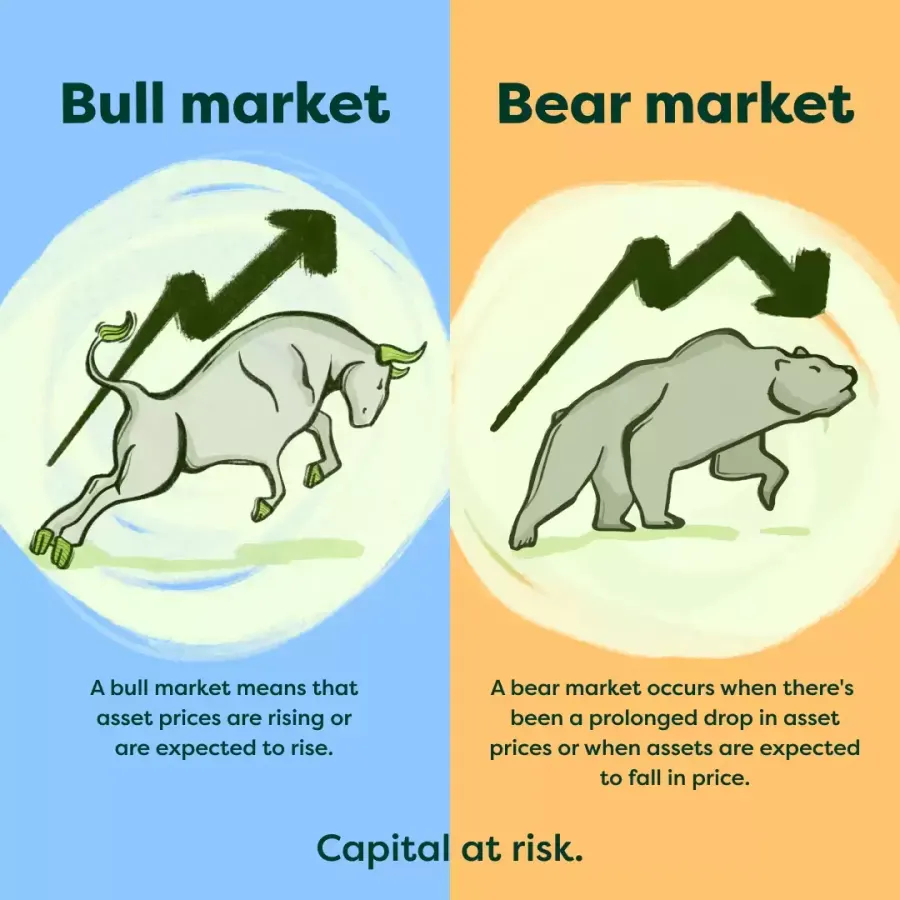Important: This information is for guidance purposes and may become out of date at any given time. It is not investment advice. Investments can rise and fall in value. We won’t make any assessment of whether the investments you chose are appropriate or suitable for you. If you are unsure of the suitability of any investment, investment service or strategy, you should seek independent financial advice. Past performance does not indicate future results. Capital is at risk.
Investing in bull markets when the economy is booming can seem simple. Investing during a recession or bear market when assets are broadly falling in price is more difficult.
So, what do you do when uncertainty persists? There are steps investors have historically taken to limit the impact of falling equity markets. Of course, no strategy is ever guaranteed to be 100% successful.

Having the right set up
Even if the markets look rosy, it’s worth doing a quick hygiene check on your portfolio every now and again.
You may want to check, for example, whether your investments match your risk tolerance and time horizon. If they don’t, you may need to make some changes to the way your portfolio is constructed so you’re not caught off guard by a sudden change in the markets or the economy. Also, as you get closer to financial goal, you may be more sensitive to market movements in order to preserve the wealth you’ve amassed.
And remember, as asset prices move, the composition of your portfolio changes. If you want to maintain your mix of assets, you’ll need to rebalance regularly.
Where do people invest when times are tough?
When times seem tough, history tells us there are some companies that fare better than others if you are looking for places to invest.
Cyclical companies have typically done poorly in a downturn. These stocks follow the ebbs and flows of the macroeconomic backdrop. When the economy is buoyant, so are they.
A lot of cyclical stocks sell consumer discretionary items or services – think luxury brands, travel, or entertainment; things that people spend money on when they have cash to spare. In a downturn, they tend to be impacted as consumers tighten their purse-strings.
Think about it. If you suddenly found yourself with less disposable income, would you give up toilet paper in order to buy a designer pair of jeans? The answer (we sincerely hope) would be “no”. Those jeans are a consumer discretionary item, and fewer consumers are likely to buy them when the macroeconomic environment is challenging.
Defensive stocks
In contrast, “defensive” companies have typically weathered tough markets better. That’s because they sell essential goods that consumers have to keep on buying no matter what – think groceries, utilities, and healthcare (and, yes, toilet paper). During difficult market conditions, many investors seek to diversify their portfolios to include more of these defensive names.
"While spreading the risk in your portfolio is a common strategy in all types of markets, a negative economic environment may also require you to consider a greater allocation to less-risky assets."
While spreading the risk in your portfolio is a common strategy in all types of markets, a negative economic environment may also require you to consider a greater allocation to less-risky assets. For a lot of investors this may mean exploring high-quality bonds, commodities like gold and cash-like investments. These assets tend to have lower returns than stocks, but also offer less downside risk – they often won’t lose as much (or might even be able to eke out a return) in bear markets.
Cashing out
Let’s say stocks fall suddenly and catch you off-guard. While it may be tempting to run when markets are flashing red, pulling your money out often has a future impact on long-term investors.
You may end up selling assets for less than you bought them for, which can harm progress towards financial goals. For this reason, many investors with longer time horizons choose to “ride out” downturns by staying invested and benefitting from the eventual recovery in stock prices.
No one knows what the future holds, and no one can predict the direction of markets, but history tells us that, over the long term, stock markets trend upwards, punctuated by short-term periods of volatility.
If you can afford it, then continuing to drip money into the markets when they are down may mean you’re able to acquire certain assets below what their true market value is. That means there’s the potential to add to gains when the market eventually recovers – you’re buying low and looking to sell high. Of course, past performance is no indication of future results and there’s never a guarantee that any particular stock will rise with the broader market.
History also suggests that failing to be invested when the market rebounds is costly. Data from Ned Davis Research, Morningstar and Hartford Funds has shown 78% of the S&P 500’s best days have historically occurred during a bear market or during the first two months of a bull market.
If you missed the 10 best market days (as of February 2023) over the past 30 years, your returns would be half of what you could expect if you’d remained investing. Missing the best 30 days over the past three decades would reduce your returns by 83%. Again, these figures are not indicative of future returns.
When will markets recover?
Bear markets aren’t much fun, but they are to be expected.
According to Ned Davis Research, the S&P 500, has experienced 27 bear markets since 1928, alongside 27 bull markets, as of July 2023.
The average length of a bear market is 292 days, or 9.7 months, so downturns don’t last forever. While aggressive price falls and uncertainty that surrounds them can cause concerns, they can also throw up opportunities to top up your portfolio with assets that may be undervalued due to the current climate.





